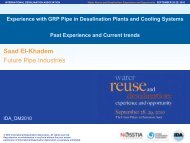View Technical Program - Levant Desalination Association
View Technical Program - Levant Desalination Association
View Technical Program - Levant Desalination Association
You also want an ePaper? Increase the reach of your titles
YUMPU automatically turns print PDFs into web optimized ePapers that Google loves.
EFFLUENT ORGANIC MATTER: STRUCTURAL CHARACTERIZATION<br />
AND FOULING PROPERTIES OF LOW PRESSURE MEMBRANE<br />
Jean-Philippe Croue<br />
Professor in Environmental Engineering – KAUST – Kingdom of Saudi Arabia<br />
REF# IDA_DM2010-Croue<br />
ABSTRACT<br />
The exact role and contribution of biopolymeric materials (extracellular polymeric<br />
substances – EPS – and soluble microbial products – SMP) in MBR fouling or UF<br />
tertiary treatment fouling still need to be more investigated and understood in order<br />
to optimize operational conditions. The proposed research aims to characterize the<br />
biopolymer composition of MBR supernatant and effluent organic matter (EfOM)<br />
using direct and indirect approaches and identify the main fractions responsible for<br />
low pressure membrane fouling.<br />
The first phase of this work was directed to characterize effluent organic matter<br />
(EfOM) by combining operationally defined categorization protocols with stateofthe-<br />
art analytical techniques to investigate the bulk of organics with respect to<br />
origin, size, structure, and functionality. Samples were collected from waste water<br />
effluents (aerobic sludge treatment with long and short contact time) and MBR<br />
reactors (pilot scale reactors operating under different sludge wasting regime; full<br />
scale plants). After performing direct analyses (DOC, UV, LC-OCD) large volume<br />
of samples were subjected to the comprehensive XAD-resin isolation protocol<br />
proposed by Leenheer et al. (2000). The isolated fractions were subjected to a large<br />
variety of analytical tools including, elemental analysis, FT-IR, 13 C-NMR, Delta 13 C,<br />
pyrolysis and thermochemolysis GC/MS, total aminoacid and aminosugar contents,<br />
fluorescence EEM. Results were compared with the data obtained from NOM<br />
fractions isolated from natural waters. The DOC profile (LC-OCD analysis) differs with<br />
the origin of the wastewater. Bulk EfOM shows higher proportion of hydrophilic<br />
colloidal structures (bacterial residues) and nitrogenous organics as compared to<br />
bulk NOM. Structural characterization tools pointed out some significant differences<br />
in term of biopolymer and molecular composition (humic vs non humics, lipids,<br />
sulphurous derivatives).<br />
The second part of the project focuses on the identification of the main fractions<br />
of EfOM responsible for the fouling of low pressure membrane (MF or UF). The<br />
experiments were conducted with MBR supernatant and pre-filtered wastewater<br />
effluent collected from plants performing long term aeration activated sludge<br />
process. Two hollow-fiber membranes, PVDF tight MF and PES UF membranes<br />
were used as home made mini modules. Short-term fouling tests performed at<br />
constant flux were developed consisting of successive filtration steps interspersed<br />
by backwashing. Fouling tests were performed before and after physical chemical<br />
treatments i.e. PAC, AER, O3 and UV/H2O2. Notice that these treatments were applied<br />
with the objective to modify the EfOM matrix. Before filtration all treated waters got<br />
their DOC content readjusted to the initial DOC using rotary evaporation. During all<br />
membrane filtration tests no significant TOC removal was noticed, however partial<br />
48<br />
Water Reuse and <strong>Desalination</strong>: Experience and Opportunity<br />
TECHNICAL PROGRAM




